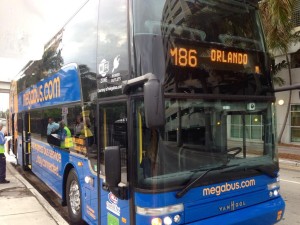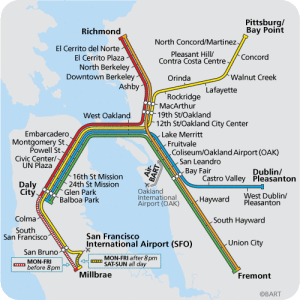We continue our look into the country’s “Megalopolises” and what kind of transportation they provide. The Atlantic’s City Lab posted an article by Richard Florida in March defining these economic hubs of the United States, which combined create more than $13 trillion in economic output.
Yesterday, we looked at the four largest regions and how they are connected (view that post here.)
So-Flo: Home to 15 million people in the Miami, Orlando and Tampa regions of Florida, public transit riders have a brand new option of travel as Megabus began service there on May 15, according to the Tampa Bay Times. Service now runs daily between Miami and Orlando, and Miami and Tampa. Travelers can also use Amtrak, which according to the company had more than 400,000 boardings in Miami, Orlando and Tampa in 2012. Riders can use the Silver Star or Silver Meteor lines.
Nor-Cal: A very densely populated part of the country , this megalopolis combines San Francisco, San Jose and Oakland for a total of 13 million people and $900 billion in economic output, according to Florida. Much like the Bos-Wash region, travelers have a plethora options at their disposal. The BART system covers much of bay area, offering lines from the east bay in Richmond, Calif. south to San Francisco International Airport.
The geography of the Bay Area, unlike many other regions, also offers ferry services such as the Golden Gate Ferry from San Francisco north to Larkspur, Calif., or the Blue & Gold Fleet that offers eight routes covering places such as Vallejo, Calif. and Sausalito, Calif. Caltrain is available for rail travel between San Francisco and San Jose, and Amtrak also covers most of the bay area with stops in San Jose, Oakland, San Francisco and continuing inland to Sacramento.
Tor-Buff-Chester: 16 million people combine to create this megalopolis, which includes metros such as Buffalo and Rochester, New York as well as Montreal and Toronto, Canada. It’s also responsible for more than $600 billion in economic output, Florida writes, that makes this region’s economic production higher than the entire country of Sweden. Toronto and Rochester, New York are separated only by Lake Ontario and while a high-speed ferry was once an option, service was discontinued in 2006 leaving travelers with flying; taking Greyhound or Megabus; or Amtrak’s aptly named Maple Leaf line, which loops around Lake Ontario stopping in Buffalo, New York first.
To add Montreal into the mix, travelers have Canada’s Via Rail that passes through Toronto and stops at Niagara Falls adjacent to Buffalo, New York.
Dal-Austin: Austin is considered the fastest growing metro area, according to Forbes, and when combined with Dallas and San Antonio, Texas, this region’s $700 billion economy generates more than oil-rich Saudi Arabia, writes Floriday.
In Austin’s case, the city’s rapid growth has left its infrastructure lagging behind and in a recent report I did for Rethinking Arizona’s Economy comparing Austin to Phoenix, Austin’s greatest weakness is transportation. City to city travel between Dallas, Austin and San Antonio has Amtrak’s Texas Eagle line, as well as Vonlane, a luxury bus service announced in April according to KHOU. Vonlane offers a luxury motor coach complete with Wi-Fi and even a six-person conference room, KHOU writes.
If luxury buses are too over the top, Megabus also offers service in Dallas, Austin and San Antonio.
Check back tomorrow as we wrap up our look into how the “Megalopolises” are connected.




